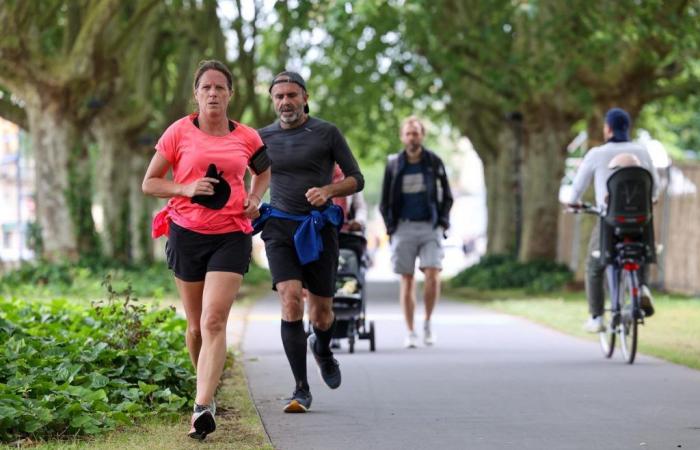Sedentary in Latin is “sedentarius”: to be seated. Charlotte Verdot, responsible for scientific expertise at Public Health France (SPF) and author, with Hélène Escalon, of the latest French health bulletin, offers a clearer definition: “Sedentary lifestyle is the time spent sitting, of course, but also lying without sleeping. We now associate this word with lack of physical activity, she says. Someone is sedentary when they don’t move enough in a day, which puts their long-term good health at risk. The risk factors are now well established by science: cardiovascular diseases, excess weight, type 2 diabetes, certain cancers and mental illnesses. »
Specifically, beyond five hours of sitting per day, we can speak of a sedentary lifestyle. Public Health France published an alarming report on June 11, reporting an excess of sedentary lifestyle among the French. One in five spends more than seven hours sitting every day. And weekend jogging doesn’t change the situation.
Thierry David / South West
Doctor Christian Daulouède is a specialist in physical and sports medicine in Bordeaux. It offers a technique to get out of a sedentary lifestyle
Christian Daulouède, a doctor specializing in physical medicine and sports in Bordeaux, for his part offers a much more radical definition of sedentary lifestyle. “A sedentary lifestyle is in itself a disease, a major risk factor. We are never too or a little sedentary, we are or not. Quite simply, man is not made to be sedentary. » In this regard, ANSES (National Health Security Agency) reports that only 5% of adults today have sufficient physical activity to be protective. The WHO (World Health Organization) and the OECD (Organization for Economic Cooperation and Development) estimate that more than 10,000 premature deaths could be avoided each year within the European Union if the recommended thresholds were met. physical activity were achieved.
Sedentary athletes: a new concept
“The data we collected,” say the two authors of the SPF study, “highlighted the lack of physical activity in the daily lives of French people, particularly among women, who are very busy with their double day. But we also observed a paradox: young adults are the most physically active, and also the most sedentary. In other words, they exercise two or three times a week, but the rest of the time, they sit for up to ten hours a day. However, one does not compensate for the other. »
Doctor Christian Daulouède has long subscribed to this paradox: the health instructions or recommendations that flourish in the media and on phone apps have perfectly permeated our lazy exhausts. The 6,000 daily steps and the thirty minutes of walking would be, according to him, “false friends”. “Of course, this comes from a good intention,” he admits. It’s about getting people back on their feet, in a state of walking, and by Jove, it’s not so bad. Here are two enlightening examples: two people who want to lose weight start jogging again, the first runs for an hour a day, the second for thirty minutes. After a few weeks, the first has lost less weight than the second. Why? After running for an hour, the first is exhausted and ends her day in an armchair, while the second still has energy and remains active. The same goes for the famous thirty minutes of walking a day: if it’s an alibi for then doing nothing all day, there’s no point. “Going for a run on the weekend and being sedentary the rest of the week, driving to work, sitting at a desk, etc., will not have any beneficial effects on your health.”
Running out of breath, sweating: going beyond the threshold of comfort
The authors of Public Health France, like Doctor Daulouède, make the same observation: “The more we sit without getting up in a day, without the slightest physical activity, even if it is only going to get bread on foot, going up and going down the stairs, the greater the health risk. We are seeing the emergence of a generation of sedentary athletes, notes Hélène Escalon. As for the recommendations, they have evolved in this direction and the messages are progressing. From now on, these thirty minutes of daily walking are still recommended, but taking into account the notion of shortness of breath. However, if 96.7% of French people have taken into account the health advice concerning thirty minutes of walking, only 22% know that this effort must be intense to be beneficial. Likewise, the quantity of steps that appear on our phone apps does not include the notion of intensity, and takes into account all steps, even small lost steps…”
So the scourge of the 2020s would be the chair? “Yes yes,” says Doctor Daulouède, “chair, sofa, armchair, bench… When you sit there for too long. We have to relearn people how to get up, straighten up to begin with, every thirty minutes. » Hélène Escalon and Charlotte Verdot, for SPF, are more realistic: “People have understood that it is necessary to get up every two hours and 9 out of 10 say they follow this recommendation. This is already good, it allows us to understand the messages about breaking away from a sedentary lifestyle. Those furthest behind remain women, monopolized by their professional and personal responsibilities. Their sedentary lifestyle is endured. Education is essential to get out of this impasse. » Clearly, being in good health depends not only on daily physical activity but also on sporting activity.
Christian Daulouède proposes to break this vicious circle of inactivity, it is based on three pillars: activity must be associated with pleasure. “Tyrannical sport does not bring profit. » You have to vary your pleasures: active walking, cycling, tennis, swimming, and you have to increase the dose regularly. “Doing sport,” he explains, “is about changing metabolism, and for that, it is necessary to exceed a comfort threshold, so that the heart accelerates, to sweat and secrete hormones. This advice is empirical. By running out of breath we capture more oxygen, we oxidize fats, we stimulate the muscles, vessels, cartilage. And for the body to race, to burn in this way, we must surpass ourselves. This model is true at any age but must be applied depending on age. Seen like this, sport is a real medicine in its own right. »






